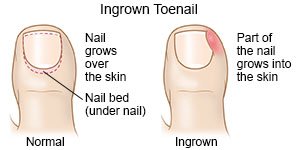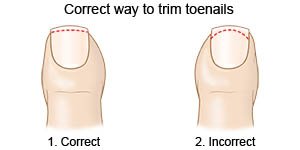Ingrown Nail
Medically reviewed by Drugs.com. Last updated on Apr 6, 2025.
AMBULATORY CARE:
An ingrown nail
is when the edge of your fingernail or toenail grows into the skin next to it. The most common cause is when nails are trimmed too short.
 |
Common symptoms include the following:
- Painful, red, and swollen skin around your nail
- Sharp pain when you walk
- Pus around your cuticle (skin around your nail)
Seek care immediately if:
- You have a red streak running up your leg or arm.
Contact your healthcare provider if:
- Your pain is getting worse.
- Your nail and skin are more swollen or start to drain pus.
- You have a fever or chills.
- Your ingrown nail is not better in 7 days.
- You have questions or concerns about your condition or care.
Medicines:
- Acetaminophen decreases pain and can be bought without a doctor's order. Ask how much to take and how often to take it. Follow directions. Acetaminophen can cause liver damage if not taken correctly.
- NSAIDs , such as ibuprofen, help decrease swelling, pain, and fever. This medicine is available with or without a doctor's order. NSAIDs can cause stomach bleeding or kidney problems in certain people. If you take blood thinner medicine, always ask your healthcare provider if NSAIDs are safe for you. Always read the medicine label and follow directions.
- Antibiotics help treat or prevent a bacterial infection. They may be given as an ointment, pill, or both.
- Take your medicine as directed. Contact your healthcare provider if you think your medicine is not helping or if you have side effects. Tell your provider if you are allergic to any medicine. Keep a list of the medicines, vitamins, and herbs you take. Include the amounts, and when and why you take them. Bring the list or the pill bottles to follow-up visits. Carry your medicine list with you in case of an emergency.
Self-care:
- Soak and lift the nail. Soak your ingrown nail in warm water for 20 minutes, 2 to 3 times each day. Then gently lift the edge of the ingrown nail away from the skin. Wedge a small piece of cotton or gauze under the corner of the nail. You can also put dental floss under the nail to lift the edge away from the skin. This may help keep the nail from growing into the skin.
- Keep your nails clean and dry. Wash your hands and feet with soap and water. Pat dry with a clean towel. Dry in between each toe. Do not put lotion between your toes.
Prevent another ingrown nail:
- Carefully trim your nails. Cut your nails straight across. Do not cut them too short. Lightly file the nail corners if you have sharp edges. Do not round your nails. Do not rip or tear off the tips of your nails. This may cause your nail edge to grow into the skin. Use clippers, not nail scissors.

- Wear shoes and socks that fit well. Make sure they are not too tight. You may need to wear a shoe with the toe cut out, such as sandals, until your ingrown toenail heals. Do not wear shoes that have pointed toes or heels that are more than 2 inches high. Do not wear tight hose or socks. Wear socks that pull moisture away from your feet, such as cotton-acrylic blends.
- Inspect your nails daily. Look for signs of an ingrown nail. Manage problems early so the nail does not become infected.
Follow up with your healthcare provider as directed:
You may be referred to a podiatrist. Write down your questions so you remember to ask them during your visits.
© Copyright Merative 2025 Information is for End User's use only and may not be sold, redistributed or otherwise used for commercial purposes.
The above information is an educational aid only. It is not intended as medical advice for individual conditions or treatments. Talk to your doctor, nurse or pharmacist before following any medical regimen to see if it is safe and effective for you.
Further information
Always consult your healthcare provider to ensure the information displayed on this page applies to your personal circumstances.
